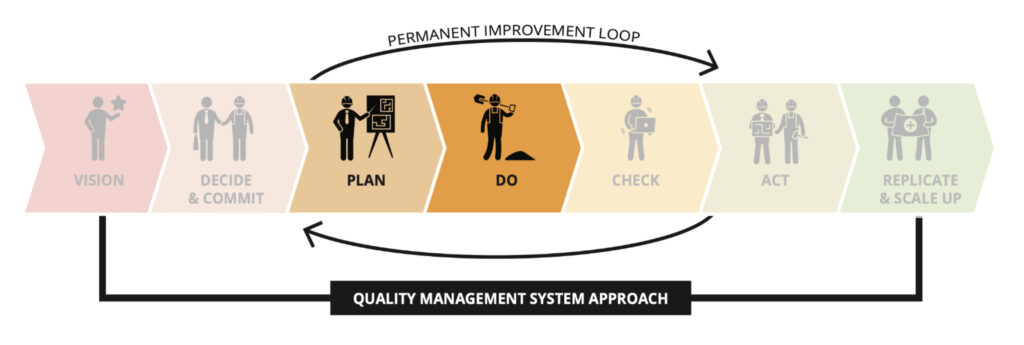NEB ambition
The ultimate ambition of the New European Bauhaus is to achieve transformation. To do this, the NEB Compass has identified specific levels of ambition that outline the desired outcomes for each of the NEB values.
The ultimate ambition of the New European Bauhaus is to achieve transformation. To do this, the NEB Compass has identified specific levels of ambition that outline the desired outcomes for each of the NEB values.
These areas refer to the five key domains of intervention that CrAFt's New European Bauhaus Impact Model considers essential for guiding and evaluating complex urban initiatives.
The participation level refers to the degree or extent to which individuals or groups are actively involved or engaged in a particular activity, project, or process. It assesses the depth of their involvement, contributions, and commitment, ranging from minimal or passive participation to active and dedicated participation.
The New European Bauhaus (NEB) aims to promote the values of sustainability, aesthetics, and inclusion in the design and transformation of urban spaces. It emphasises the integration of environmental, social, and economic considerations to create harmonious and innovative living environments.
According to the Smart City Guidance Package, there are seven stages to plan and implement smart city projects. These stages propose a logical and coherent roadmap for city initiatives involving many stakeholders.
CrAFt Cities Session 6 —8 March 2023— recapitulated from the two previous sessions. Judith Borsboom presented the Smart Cities Guidance Package stages 3 and 4 related to the planning and implementation of climate neutrality programmes and projects.

The first two guest speakers of the session were the representatives from the City of Amstelveen. Netherlands, Saskia Zorge, strategy advisor for sustainability, and Patrick Lie, project manager for the energy transition. They presented the city’s plan for energy transition, circular economy and climate adaptation (PLECK) and their Neighbourhood Sustainability Plans.
Amstelveen’s objectives are to become a CO2 emission-free municipal organisation by 2030, an emissions-free city by 2040 and a circular city by 2050. Patrick and Saskia introduced a few of the city’s initiatives to reach their goals. Among them are the energy coaches and the collective purchases of materials—such as solar panels—and webinars to train citizens on reducing energy consumption.The main challenges that Amstelveen is facing regarding the implementation of its energy transition programmes are:
What they have learnt in this process is that:
In the second half of the session, Zoya Stoyanova, senior expert in strategic planning, digitalisation and sustainable development at the City of Burgas, Bulgaria, presented the city’s approach to re-valuing urban planning and design for climate neutrality.
The city of Burgas is located on a peninsula with tremendous biodiversity. Therefore the city development presents several challenges, such as the limited expansion of the city to the south and north directions, and how to ensure industrial and economic development while preserving the unique ecosystem and biodiversity of the area.
Burgas’ integrated urban development plan for 2021 -2027 is a holistic cross-domain initiative that seeks to maintain social and distributive justice and pave pathways for policies to integrate the New European Bauhaus principles into urban planning. Some of the reasons why this plan has been so successful so far are because they:
In the breakout sessions, the participants discussed several related topics, such as how, on paper, the steps for planning and implementing those plans are very relevant and present the ideal process. Still, in practice, this is often challenging. For instance, one of the participant cities faced a planning problem due to EU regulations contradicting the local regulations in the construction process.
Another group discussed pulling in people of different disciplines and perspectives to ensure a diverse co-creation process. And how these types of strategies focus on inclusivity, with efforts towards reaching people of different genders, ages and cultural backgrounds. There is also an emphasis on reaching the residents that live close to any project, seeking to find their wants and needs, and including them in the process to foster a sense of common ownership of the project.
For some cities, it’s easier to start implementing small public projects to showcase what they aim to do at a larger scale than planning for large-scale projects without testing what people’s reactions will be. Involving students and artists has proven to be an excellent way to spark curiosity among citizens and to present the city’s plans in ways which are accessible and easy to understand for everyone.
In general, cities need help understanding how to integrate the New European Bauhaus (NEB) principles into their climate neutrality programmes and projects, as well as how to explain NEB to their stakeholders and citizens.